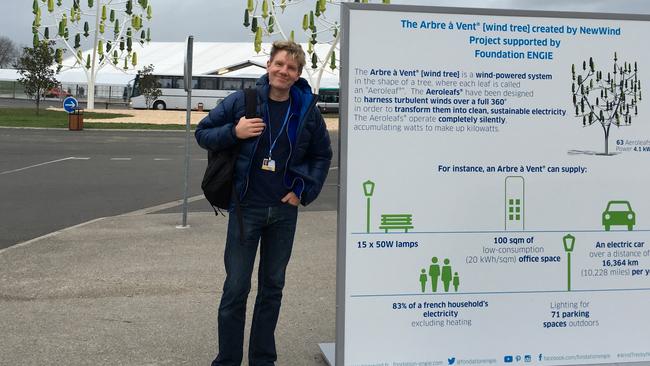Paris climate conference: blowing a chance to help the planet

Outside the Paris climate conference centre, organisers have erected a “wind tree” (arbre a vent), which produces electricity using the power of the breeze. In doing so, they have summed up exactly what is wrong with the conference.
The tree will only produce 3500 kWh a year and it costs about $37,100. So, at a production price of about 11c a year, it will take 89 years to make up just the capital cost. Or, put differently, the cost is 300 per cent more expensive than even traditional wind power, which still struggles without subsidies.
The Conference of Parties (COP21) is about feeling good: spending a lot of money to do very little good, and not about making the choices that will make any difference.
This summit is “the last chance” to avert dangerous temperature rises, if we listen to the Earth League or a bunch of others. It’s going to be “too late” if a meaningful treaty isn’t negotiated here in the next few days, says the French President. It’s a familiar script. Doom-laden warnings about the “last chance to save the planet” date as far back as the earliest climate summits 20 years ago. Time magazine declared 2001 “a global warming treaty’s last chance”, and in 1989 the UN Environment Programme’s executive director warned that the planet faced an ecological disaster “as final as nuclear war” by the turn of the century.
Amid this alarmism, for 20 years well-intentioned climate negotiators have tried to do the same thing over and over and over again: negotiate a treaty that makes an impact on temperature rises. The result? Twenty years of failure with no significant effect on climate change.
These summits have failed for a pretty simple reason. Solar and wind power are still too expensive and inefficient to replace fossil fuels. The Copenhagen-Paris approach requires us to force immature green technologies on the world even though they are not ready or competitive. That’s hugely expensive and inefficient.
Thanks to campaigning non-governmental organisations, politicians and self-interested green energy companies that benefit from huge subsidies, many people believe that solar and wind energy are already major sources of energy.
The reality is that even after two decades of climate talks, they account for a meagre 0.5 per cent of total global energy consumption, according to the International Energy Agency.
And 25 years from now, even envisioning everyone doing all that they promise in Paris, the IEA expects we will get just 2.4 per cent from solar and wind. That tells us that the innovation that’s required to wean the planet off reliance on fossil fuels is not taking place.
That’s why the one glimmer of hope in Paris has been the announcement by Bill Gates, along with Australia, China, India and the US, of a multi-billion-dollar fund for green R&D.
The $27 billion fund is just a first step, but it’s a vitally important one. Just as massive support for research and development got us to the moon, the aim is for a massive focus on green research and development to make climate-friendly forms of energy competitive. This is precisely what the Copenhagen Consensus Centre and I have been arguing for more than eight years.
In a recent peer-reviewed research paper, I looked at all the carbon-cutting promises countries committed to ahead of Paris (their so-called intended nationally determined contributions, or INDCs) for the years 2016-30.
These are what the Paris global treaty will be based on (along with a lot of claims about what might happen outside those dates — something that’s easy for politicians of today to talk about, but that we just can’t take seriously).
What I found when I looked at the national promises was that they would cut global temperatures by just 0.05C by 2100.
And even if every government on the planet not only keeps every Paris promise, reduces all emissions by 2030 and shifts no emissions to other countries, but also keeps these emission reductions throughout the rest of the century, temperatures will be reduced by just 0.17C by the year 2100.
And let’s be clear, that is incredibly — probably even ridiculously — optimistic. Consider the Kyoto Protocol, signed in 1997, never ratified by the US, and eventually abandoned by Canada and Russia and Japan. After several renegotiations, the Kyoto Protocol had been weakened to the point that the hot air left from the collapse of the Soviet Union exceeded the entire promised reductions, leaving the treaty essentially toothless.
The cost of these policies? Extraordinarily, UN officials provide no official estimated costs for the likely treaty. So we are left to make an unofficial tally, which we can do easily enough by adding up the costs of Paris promises submitted by the US, European Union, Mexico and China, which together account for about 80 per cent of the globe’s pledged emissions reductions.
In total, the Paris promises of these four countries/groupings will diminish the global economy by at least $1 trillion a year by 2030 — and that is in an ideal world, where politicians consistently reduce emissions in the most effective, smartest possible ways.
But that won’t happen. It never has in history.
Politicians have a habit of wasting money on phenomenally inefficient subsidies for solar and biofuels. And based on the EU experience, such waste can double the costs of carbon-cutting policies to $2 trillion. That’s $1 to $2 trillion that won’t be spent on global challenges such as malnutrition, poverty and communicable diseases.
We are spending a fortune to make ourselves feel like we are saving the planet. The “wind tree” is an excellent symbol of what’s wrong with Paris.
Bjorn Lomborg is an adjunct professor at the Copenhagen Business School and directs the Copenhagen Consensus Centre.



To join the conversation, please log in. Don't have an account? Register
Join the conversation, you are commenting as Logout